Contract and Negligence: Comprehensive Analysis and Application
VerifiedAdded on 2020/01/23
|14
|4560
|133
Report
AI Summary
This report provides a comprehensive overview of contract law and negligence. It begins with an introduction to contracts, defining key elements such as offer, acceptance, consideration, and capacity. The report distinguishes between different types of contracts, including unilateral and bilateral contracts, contracts under seal, and written versus verbal contracts. It then explores contract terms, including implied, express, and innominate terms, as well as exclusion clauses. The report includes case studies analyzing scenarios involving breach of contract and the application of contract law principles. The report also delves into the concept of negligence as a tort, defining negligence and tortious liability. It further explains the relationship between contractual and tortious liability and provides real-world examples to illustrate the concepts. The report analyzes cases where contracts were breached, and determines liability based on the facts provided.
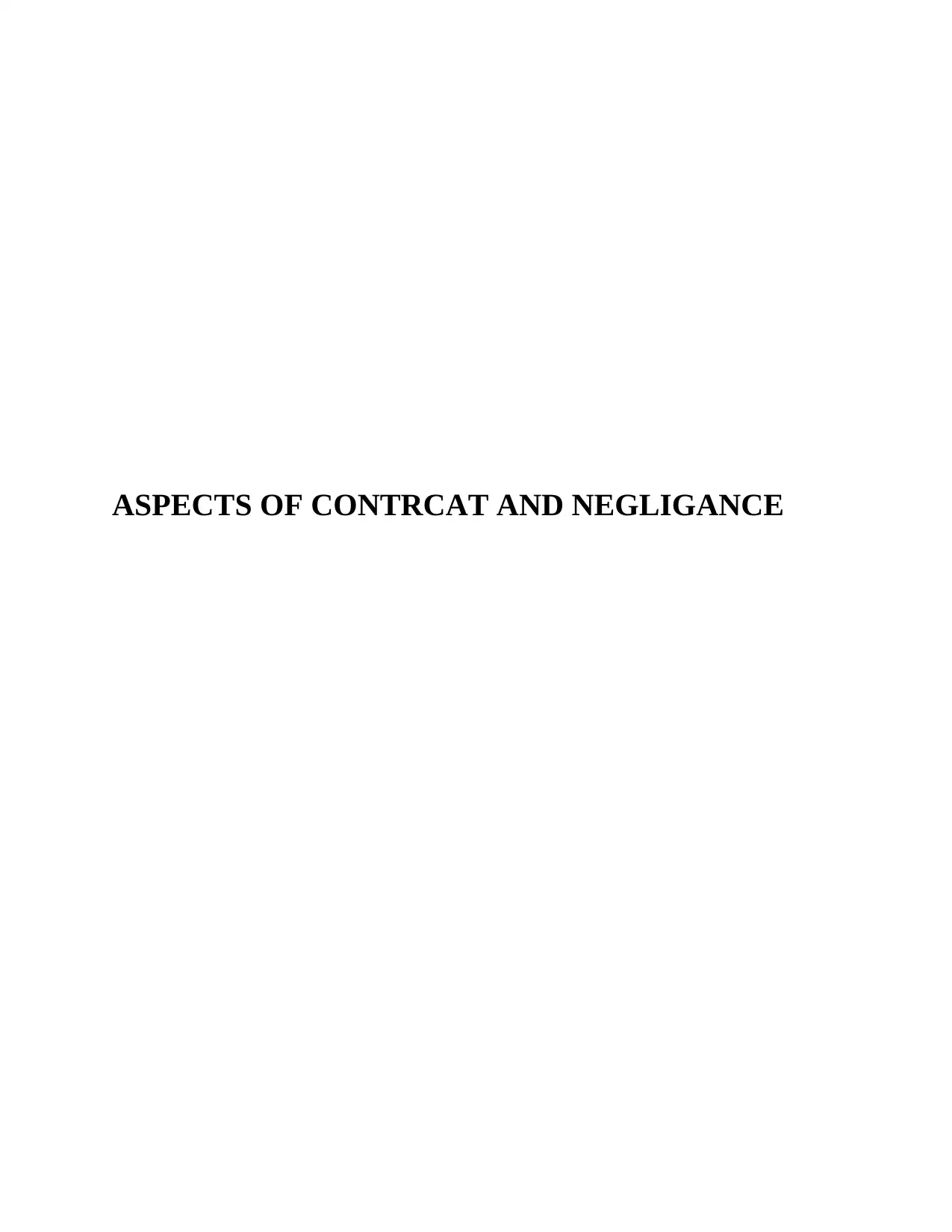
ASPECTS OF CONTRCAT AND NEGLIGANCE
Paraphrase This Document
Need a fresh take? Get an instant paraphrase of this document with our AI Paraphraser
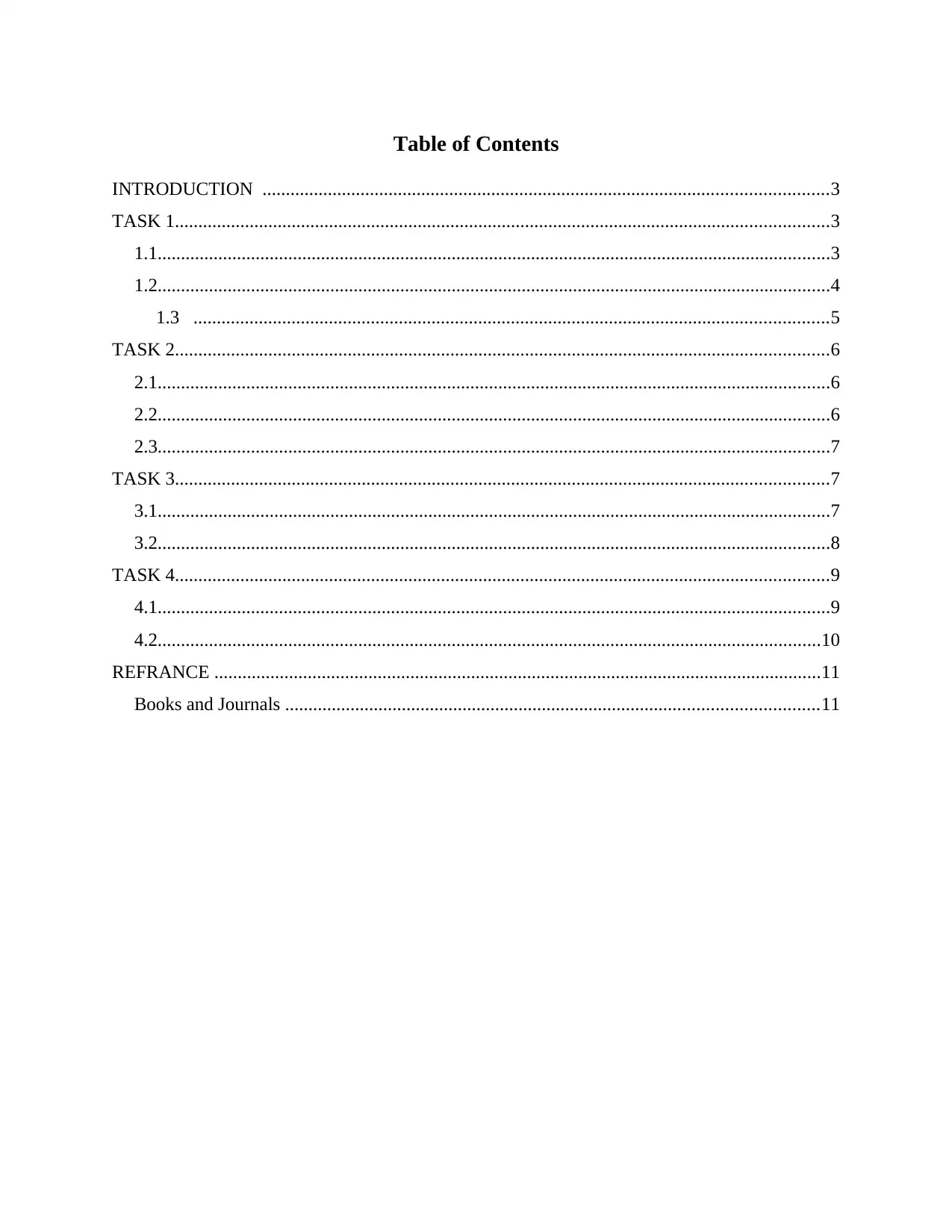
Table of Contents
INTRODUCTION .........................................................................................................................3
TASK 1............................................................................................................................................3
1.1................................................................................................................................................3
1.2................................................................................................................................................4
1.3 ........................................................................................................................................5
TASK 2............................................................................................................................................6
2.1................................................................................................................................................6
2.2................................................................................................................................................6
2.3................................................................................................................................................7
TASK 3............................................................................................................................................7
3.1................................................................................................................................................7
3.2................................................................................................................................................8
TASK 4............................................................................................................................................9
4.1................................................................................................................................................9
4.2..............................................................................................................................................10
REFRANCE ..................................................................................................................................11
Books and Journals ..................................................................................................................11
INTRODUCTION .........................................................................................................................3
TASK 1............................................................................................................................................3
1.1................................................................................................................................................3
1.2................................................................................................................................................4
1.3 ........................................................................................................................................5
TASK 2............................................................................................................................................6
2.1................................................................................................................................................6
2.2................................................................................................................................................6
2.3................................................................................................................................................7
TASK 3............................................................................................................................................7
3.1................................................................................................................................................7
3.2................................................................................................................................................8
TASK 4............................................................................................................................................9
4.1................................................................................................................................................9
4.2..............................................................................................................................................10
REFRANCE ..................................................................................................................................11
Books and Journals ..................................................................................................................11
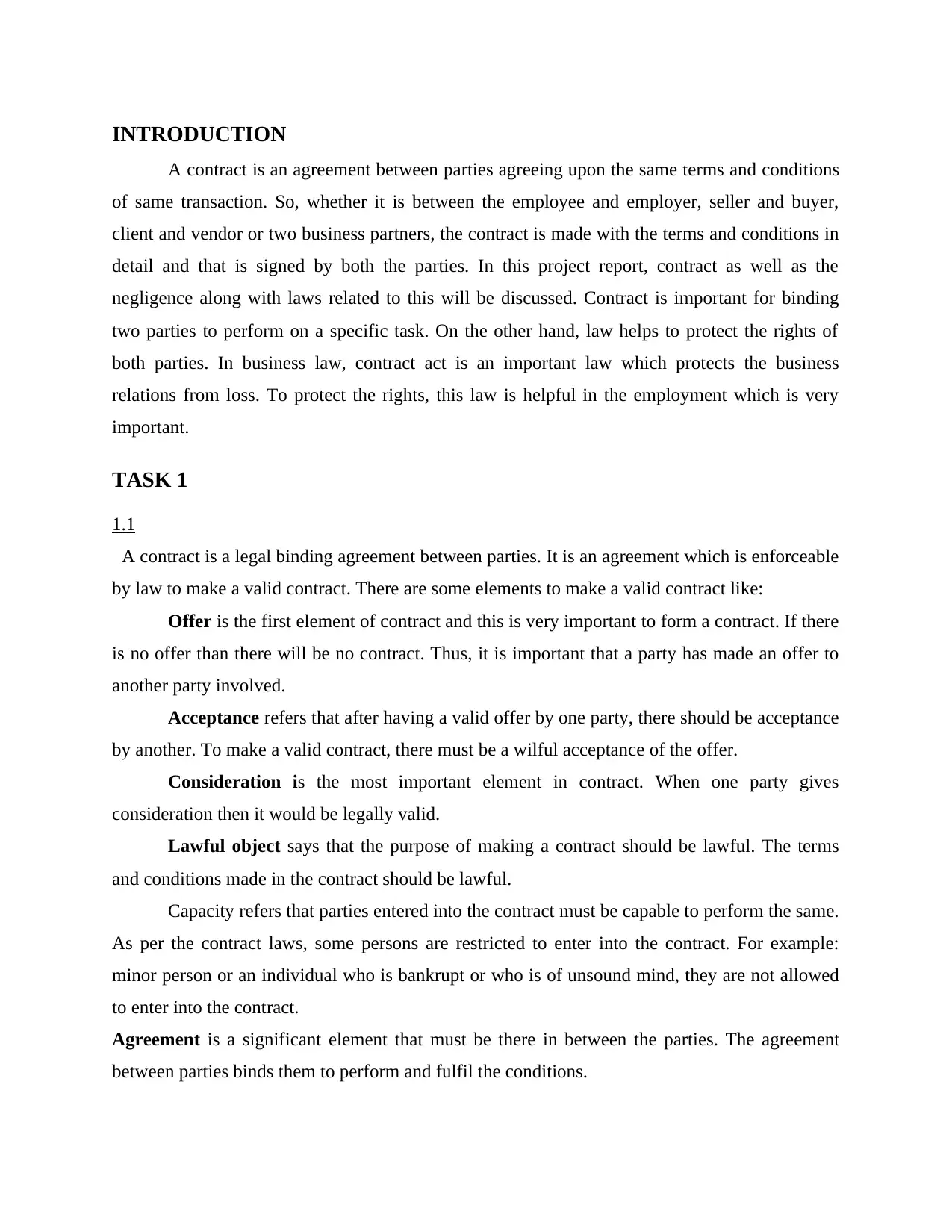
INTRODUCTION
A contract is an agreement between parties agreeing upon the same terms and conditions
of same transaction. So, whether it is between the employee and employer, seller and buyer,
client and vendor or two business partners, the contract is made with the terms and conditions in
detail and that is signed by both the parties. In this project report, contract as well as the
negligence along with laws related to this will be discussed. Contract is important for binding
two parties to perform on a specific task. On the other hand, law helps to protect the rights of
both parties. In business law, contract act is an important law which protects the business
relations from loss. To protect the rights, this law is helpful in the employment which is very
important.
TASK 1
1.1
A contract is a legal binding agreement between parties. It is an agreement which is enforceable
by law to make a valid contract. There are some elements to make a valid contract like:
Offer is the first element of contract and this is very important to form a contract. If there
is no offer than there will be no contract. Thus, it is important that a party has made an offer to
another party involved.
Acceptance refers that after having a valid offer by one party, there should be acceptance
by another. To make a valid contract, there must be a wilful acceptance of the offer.
Consideration is the most important element in contract. When one party gives
consideration then it would be legally valid.
Lawful object says that the purpose of making a contract should be lawful. The terms
and conditions made in the contract should be lawful.
Capacity refers that parties entered into the contract must be capable to perform the same.
As per the contract laws, some persons are restricted to enter into the contract. For example:
minor person or an individual who is bankrupt or who is of unsound mind, they are not allowed
to enter into the contract.
Agreement is a significant element that must be there in between the parties. The agreement
between parties binds them to perform and fulfil the conditions.
A contract is an agreement between parties agreeing upon the same terms and conditions
of same transaction. So, whether it is between the employee and employer, seller and buyer,
client and vendor or two business partners, the contract is made with the terms and conditions in
detail and that is signed by both the parties. In this project report, contract as well as the
negligence along with laws related to this will be discussed. Contract is important for binding
two parties to perform on a specific task. On the other hand, law helps to protect the rights of
both parties. In business law, contract act is an important law which protects the business
relations from loss. To protect the rights, this law is helpful in the employment which is very
important.
TASK 1
1.1
A contract is a legal binding agreement between parties. It is an agreement which is enforceable
by law to make a valid contract. There are some elements to make a valid contract like:
Offer is the first element of contract and this is very important to form a contract. If there
is no offer than there will be no contract. Thus, it is important that a party has made an offer to
another party involved.
Acceptance refers that after having a valid offer by one party, there should be acceptance
by another. To make a valid contract, there must be a wilful acceptance of the offer.
Consideration is the most important element in contract. When one party gives
consideration then it would be legally valid.
Lawful object says that the purpose of making a contract should be lawful. The terms
and conditions made in the contract should be lawful.
Capacity refers that parties entered into the contract must be capable to perform the same.
As per the contract laws, some persons are restricted to enter into the contract. For example:
minor person or an individual who is bankrupt or who is of unsound mind, they are not allowed
to enter into the contract.
Agreement is a significant element that must be there in between the parties. The agreement
between parties binds them to perform and fulfil the conditions.
⊘ This is a preview!⊘
Do you want full access?
Subscribe today to unlock all pages.

Trusted by 1+ million students worldwide
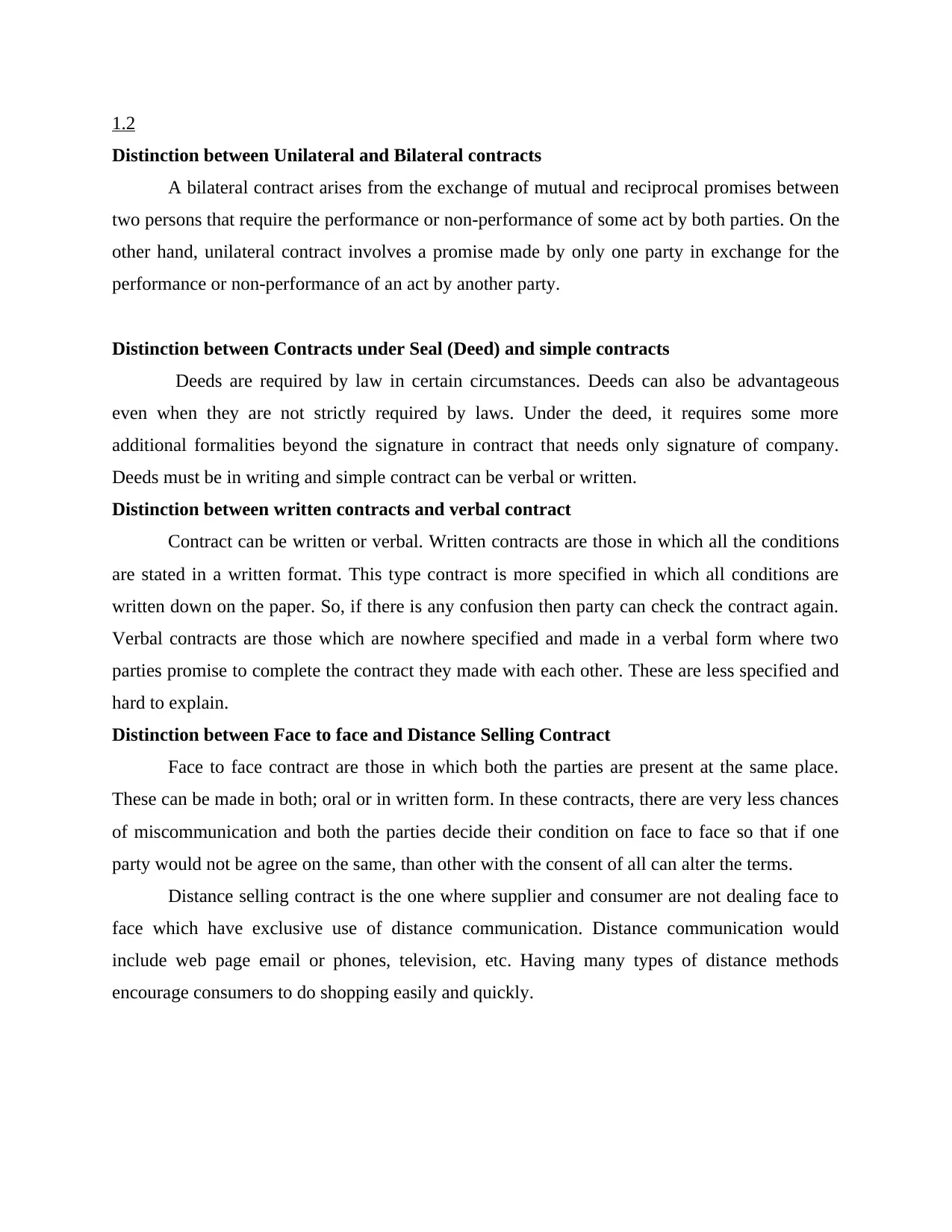
1.2
Distinction between Unilateral and Bilateral contracts
A bilateral contract arises from the exchange of mutual and reciprocal promises between
two persons that require the performance or non-performance of some act by both parties. On the
other hand, unilateral contract involves a promise made by only one party in exchange for the
performance or non-performance of an act by another party.
Distinction between Contracts under Seal (Deed) and simple contracts
Deeds are required by law in certain circumstances. Deeds can also be advantageous
even when they are not strictly required by laws. Under the deed, it requires some more
additional formalities beyond the signature in contract that needs only signature of company.
Deeds must be in writing and simple contract can be verbal or written.
Distinction between written contracts and verbal contract
Contract can be written or verbal. Written contracts are those in which all the conditions
are stated in a written format. This type contract is more specified in which all conditions are
written down on the paper. So, if there is any confusion then party can check the contract again.
Verbal contracts are those which are nowhere specified and made in a verbal form where two
parties promise to complete the contract they made with each other. These are less specified and
hard to explain.
Distinction between Face to face and Distance Selling Contract
Face to face contract are those in which both the parties are present at the same place.
These can be made in both; oral or in written form. In these contracts, there are very less chances
of miscommunication and both the parties decide their condition on face to face so that if one
party would not be agree on the same, than other with the consent of all can alter the terms.
Distance selling contract is the one where supplier and consumer are not dealing face to
face which have exclusive use of distance communication. Distance communication would
include web page email or phones, television, etc. Having many types of distance methods
encourage consumers to do shopping easily and quickly.
Distinction between Unilateral and Bilateral contracts
A bilateral contract arises from the exchange of mutual and reciprocal promises between
two persons that require the performance or non-performance of some act by both parties. On the
other hand, unilateral contract involves a promise made by only one party in exchange for the
performance or non-performance of an act by another party.
Distinction between Contracts under Seal (Deed) and simple contracts
Deeds are required by law in certain circumstances. Deeds can also be advantageous
even when they are not strictly required by laws. Under the deed, it requires some more
additional formalities beyond the signature in contract that needs only signature of company.
Deeds must be in writing and simple contract can be verbal or written.
Distinction between written contracts and verbal contract
Contract can be written or verbal. Written contracts are those in which all the conditions
are stated in a written format. This type contract is more specified in which all conditions are
written down on the paper. So, if there is any confusion then party can check the contract again.
Verbal contracts are those which are nowhere specified and made in a verbal form where two
parties promise to complete the contract they made with each other. These are less specified and
hard to explain.
Distinction between Face to face and Distance Selling Contract
Face to face contract are those in which both the parties are present at the same place.
These can be made in both; oral or in written form. In these contracts, there are very less chances
of miscommunication and both the parties decide their condition on face to face so that if one
party would not be agree on the same, than other with the consent of all can alter the terms.
Distance selling contract is the one where supplier and consumer are not dealing face to
face which have exclusive use of distance communication. Distance communication would
include web page email or phones, television, etc. Having many types of distance methods
encourage consumers to do shopping easily and quickly.
Paraphrase This Document
Need a fresh take? Get an instant paraphrase of this document with our AI Paraphraser
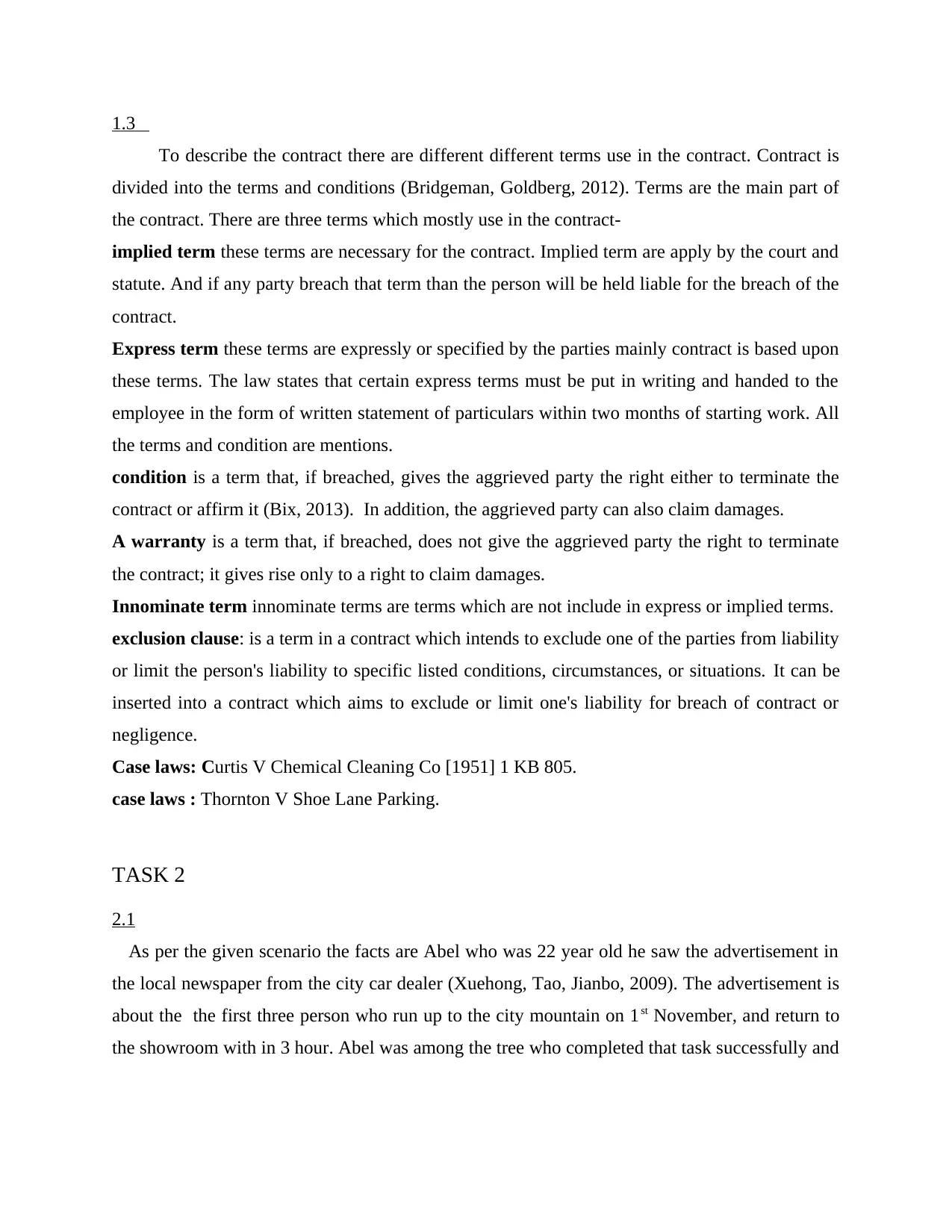
1.3
To describe the contract there are different different terms use in the contract. Contract is
divided into the terms and conditions (Bridgeman, Goldberg, 2012). Terms are the main part of
the contract. There are three terms which mostly use in the contract-
implied term these terms are necessary for the contract. Implied term are apply by the court and
statute. And if any party breach that term than the person will be held liable for the breach of the
contract.
Express term these terms are expressly or specified by the parties mainly contract is based upon
these terms. The law states that certain express terms must be put in writing and handed to the
employee in the form of written statement of particulars within two months of starting work. All
the terms and condition are mentions.
condition is a term that, if breached, gives the aggrieved party the right either to terminate the
contract or affirm it (Bix, 2013). In addition, the aggrieved party can also claim damages.
A warranty is a term that, if breached, does not give the aggrieved party the right to terminate
the contract; it gives rise only to a right to claim damages.
Innominate term innominate terms are terms which are not include in express or implied terms.
exclusion clause: is a term in a contract which intends to exclude one of the parties from liability
or limit the person's liability to specific listed conditions, circumstances, or situations. It can be
inserted into a contract which aims to exclude or limit one's liability for breach of contract or
negligence.
Case laws: Curtis V Chemical Cleaning Co [1951] 1 KB 805.
case laws : Thornton V Shoe Lane Parking.
TASK 2
2.1
As per the given scenario the facts are Abel who was 22 year old he saw the advertisement in
the local newspaper from the city car dealer (Xuehong, Tao, Jianbo, 2009). The advertisement is
about the the first three person who run up to the city mountain on 1st November, and return to
the showroom with in 3 hour. Abel was among the tree who completed that task successfully and
To describe the contract there are different different terms use in the contract. Contract is
divided into the terms and conditions (Bridgeman, Goldberg, 2012). Terms are the main part of
the contract. There are three terms which mostly use in the contract-
implied term these terms are necessary for the contract. Implied term are apply by the court and
statute. And if any party breach that term than the person will be held liable for the breach of the
contract.
Express term these terms are expressly or specified by the parties mainly contract is based upon
these terms. The law states that certain express terms must be put in writing and handed to the
employee in the form of written statement of particulars within two months of starting work. All
the terms and condition are mentions.
condition is a term that, if breached, gives the aggrieved party the right either to terminate the
contract or affirm it (Bix, 2013). In addition, the aggrieved party can also claim damages.
A warranty is a term that, if breached, does not give the aggrieved party the right to terminate
the contract; it gives rise only to a right to claim damages.
Innominate term innominate terms are terms which are not include in express or implied terms.
exclusion clause: is a term in a contract which intends to exclude one of the parties from liability
or limit the person's liability to specific listed conditions, circumstances, or situations. It can be
inserted into a contract which aims to exclude or limit one's liability for breach of contract or
negligence.
Case laws: Curtis V Chemical Cleaning Co [1951] 1 KB 805.
case laws : Thornton V Shoe Lane Parking.
TASK 2
2.1
As per the given scenario the facts are Abel who was 22 year old he saw the advertisement in
the local newspaper from the city car dealer (Xuehong, Tao, Jianbo, 2009). The advertisement is
about the the first three person who run up to the city mountain on 1st November, and return to
the showroom with in 3 hour. Abel was among the tree who completed that task successfully and
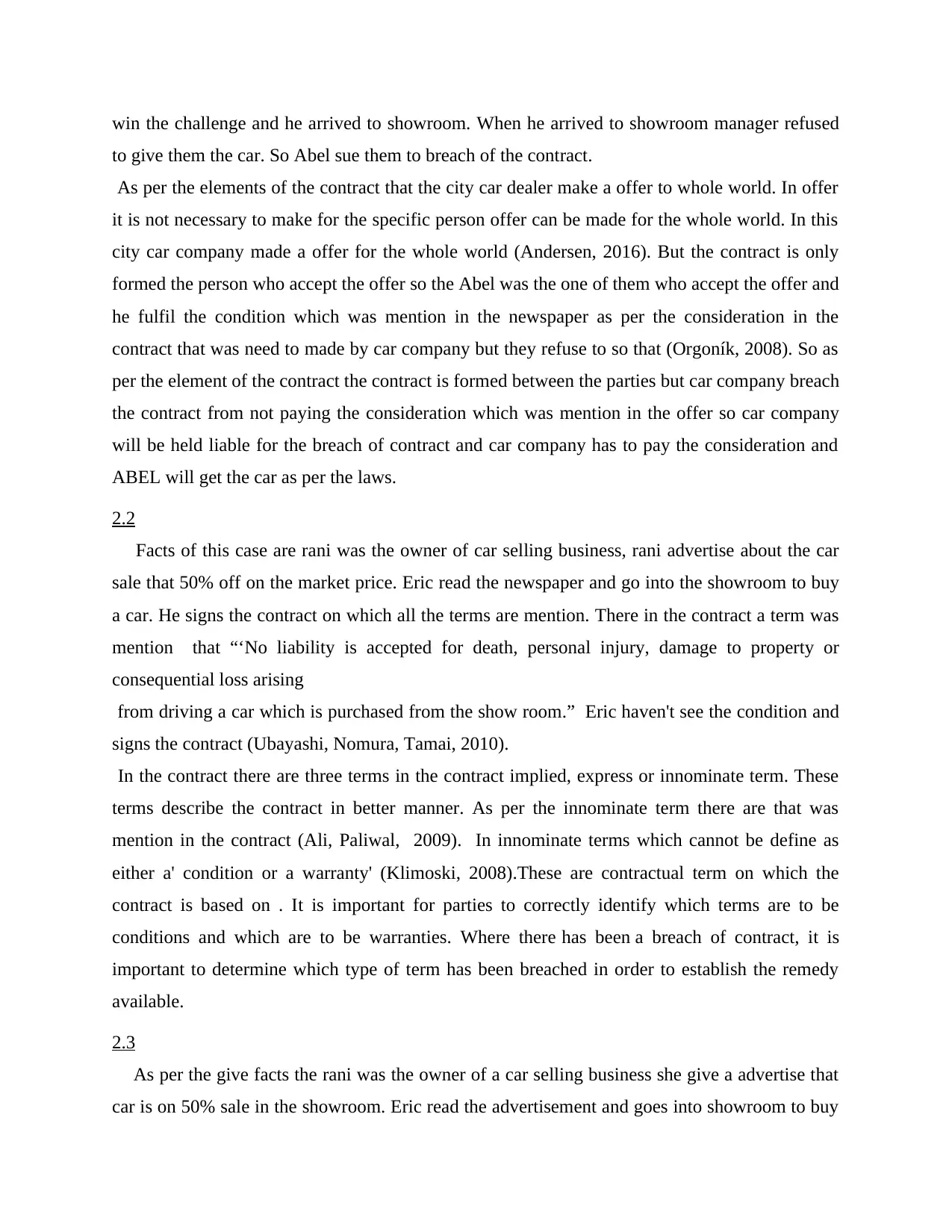
win the challenge and he arrived to showroom. When he arrived to showroom manager refused
to give them the car. So Abel sue them to breach of the contract.
As per the elements of the contract that the city car dealer make a offer to whole world. In offer
it is not necessary to make for the specific person offer can be made for the whole world. In this
city car company made a offer for the whole world (Andersen, 2016). But the contract is only
formed the person who accept the offer so the Abel was the one of them who accept the offer and
he fulfil the condition which was mention in the newspaper as per the consideration in the
contract that was need to made by car company but they refuse to so that (Orgoník, 2008). So as
per the element of the contract the contract is formed between the parties but car company breach
the contract from not paying the consideration which was mention in the offer so car company
will be held liable for the breach of contract and car company has to pay the consideration and
ABEL will get the car as per the laws.
2.2
Facts of this case are rani was the owner of car selling business, rani advertise about the car
sale that 50% off on the market price. Eric read the newspaper and go into the showroom to buy
a car. He signs the contract on which all the terms are mention. There in the contract a term was
mention that “‘No liability is accepted for death, personal injury, damage to property or
consequential loss arising
from driving a car which is purchased from the show room.” Eric haven't see the condition and
signs the contract (Ubayashi, Nomura, Tamai, 2010).
In the contract there are three terms in the contract implied, express or innominate term. These
terms describe the contract in better manner. As per the innominate term there are that was
mention in the contract (Ali, Paliwal, 2009). In innominate terms which cannot be define as
either a' condition or a warranty' (Klimoski, 2008).These are contractual term on which the
contract is based on . It is important for parties to correctly identify which terms are to be
conditions and which are to be warranties. Where there has been a breach of contract, it is
important to determine which type of term has been breached in order to establish the remedy
available.
2.3
As per the give facts the rani was the owner of a car selling business she give a advertise that
car is on 50% sale in the showroom. Eric read the advertisement and goes into showroom to buy
to give them the car. So Abel sue them to breach of the contract.
As per the elements of the contract that the city car dealer make a offer to whole world. In offer
it is not necessary to make for the specific person offer can be made for the whole world. In this
city car company made a offer for the whole world (Andersen, 2016). But the contract is only
formed the person who accept the offer so the Abel was the one of them who accept the offer and
he fulfil the condition which was mention in the newspaper as per the consideration in the
contract that was need to made by car company but they refuse to so that (Orgoník, 2008). So as
per the element of the contract the contract is formed between the parties but car company breach
the contract from not paying the consideration which was mention in the offer so car company
will be held liable for the breach of contract and car company has to pay the consideration and
ABEL will get the car as per the laws.
2.2
Facts of this case are rani was the owner of car selling business, rani advertise about the car
sale that 50% off on the market price. Eric read the newspaper and go into the showroom to buy
a car. He signs the contract on which all the terms are mention. There in the contract a term was
mention that “‘No liability is accepted for death, personal injury, damage to property or
consequential loss arising
from driving a car which is purchased from the show room.” Eric haven't see the condition and
signs the contract (Ubayashi, Nomura, Tamai, 2010).
In the contract there are three terms in the contract implied, express or innominate term. These
terms describe the contract in better manner. As per the innominate term there are that was
mention in the contract (Ali, Paliwal, 2009). In innominate terms which cannot be define as
either a' condition or a warranty' (Klimoski, 2008).These are contractual term on which the
contract is based on . It is important for parties to correctly identify which terms are to be
conditions and which are to be warranties. Where there has been a breach of contract, it is
important to determine which type of term has been breached in order to establish the remedy
available.
2.3
As per the give facts the rani was the owner of a car selling business she give a advertise that
car is on 50% sale in the showroom. Eric read the advertisement and goes into showroom to buy
⊘ This is a preview!⊘
Do you want full access?
Subscribe today to unlock all pages.

Trusted by 1+ million students worldwide
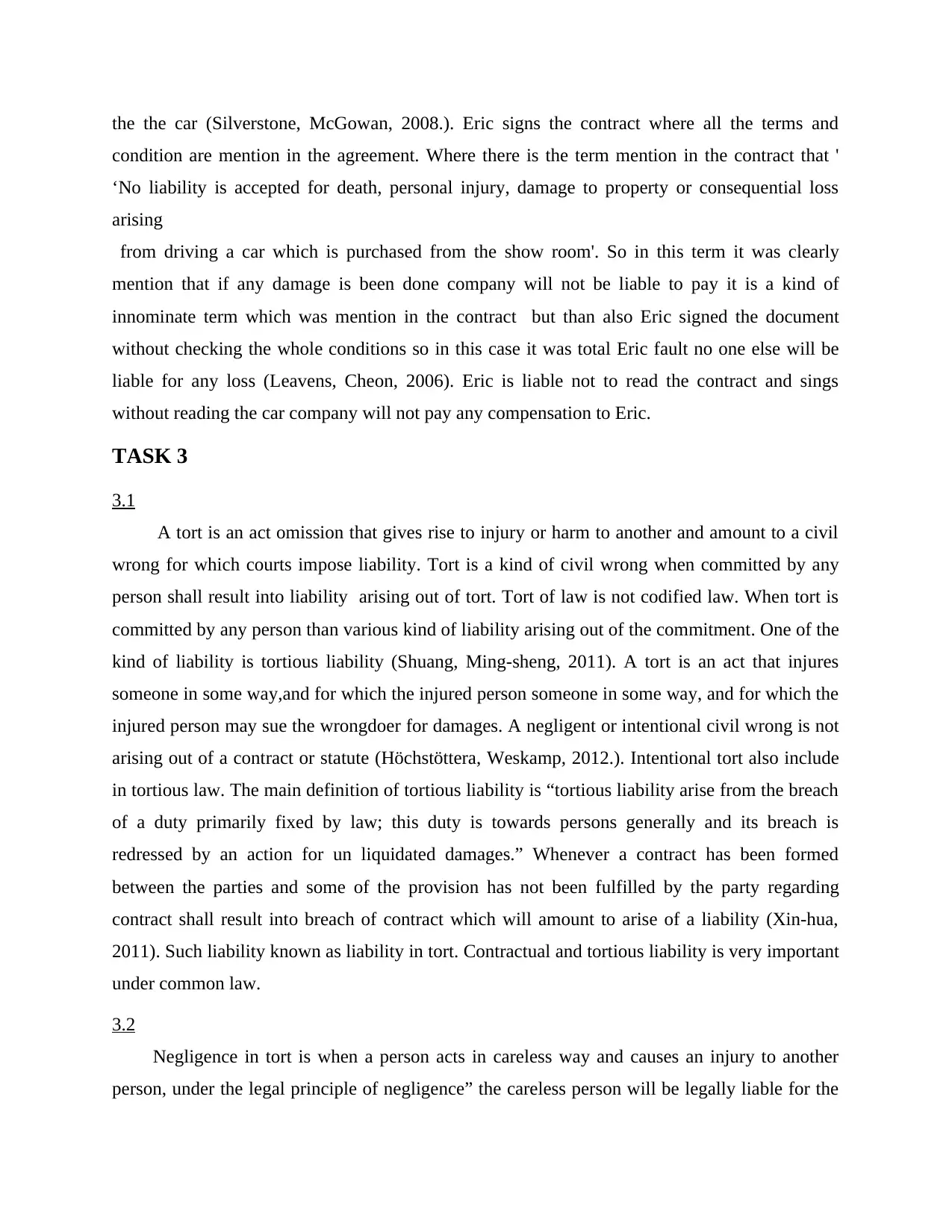
the the car (Silverstone, McGowan, 2008.). Eric signs the contract where all the terms and
condition are mention in the agreement. Where there is the term mention in the contract that '
‘No liability is accepted for death, personal injury, damage to property or consequential loss
arising
from driving a car which is purchased from the show room'. So in this term it was clearly
mention that if any damage is been done company will not be liable to pay it is a kind of
innominate term which was mention in the contract but than also Eric signed the document
without checking the whole conditions so in this case it was total Eric fault no one else will be
liable for any loss (Leavens, Cheon, 2006). Eric is liable not to read the contract and sings
without reading the car company will not pay any compensation to Eric.
TASK 3
3.1
A tort is an act omission that gives rise to injury or harm to another and amount to a civil
wrong for which courts impose liability. Tort is a kind of civil wrong when committed by any
person shall result into liability arising out of tort. Tort of law is not codified law. When tort is
committed by any person than various kind of liability arising out of the commitment. One of the
kind of liability is tortious liability (Shuang, Ming-sheng, 2011). A tort is an act that injures
someone in some way,and for which the injured person someone in some way, and for which the
injured person may sue the wrongdoer for damages. A negligent or intentional civil wrong is not
arising out of a contract or statute (Höchstöttera, Weskamp, 2012.). Intentional tort also include
in tortious law. The main definition of tortious liability is “tortious liability arise from the breach
of a duty primarily fixed by law; this duty is towards persons generally and its breach is
redressed by an action for un liquidated damages.” Whenever a contract has been formed
between the parties and some of the provision has not been fulfilled by the party regarding
contract shall result into breach of contract which will amount to arise of a liability (Xin-hua,
2011). Such liability known as liability in tort. Contractual and tortious liability is very important
under common law.
3.2
Negligence in tort is when a person acts in careless way and causes an injury to another
person, under the legal principle of negligence” the careless person will be legally liable for the
condition are mention in the agreement. Where there is the term mention in the contract that '
‘No liability is accepted for death, personal injury, damage to property or consequential loss
arising
from driving a car which is purchased from the show room'. So in this term it was clearly
mention that if any damage is been done company will not be liable to pay it is a kind of
innominate term which was mention in the contract but than also Eric signed the document
without checking the whole conditions so in this case it was total Eric fault no one else will be
liable for any loss (Leavens, Cheon, 2006). Eric is liable not to read the contract and sings
without reading the car company will not pay any compensation to Eric.
TASK 3
3.1
A tort is an act omission that gives rise to injury or harm to another and amount to a civil
wrong for which courts impose liability. Tort is a kind of civil wrong when committed by any
person shall result into liability arising out of tort. Tort of law is not codified law. When tort is
committed by any person than various kind of liability arising out of the commitment. One of the
kind of liability is tortious liability (Shuang, Ming-sheng, 2011). A tort is an act that injures
someone in some way,and for which the injured person someone in some way, and for which the
injured person may sue the wrongdoer for damages. A negligent or intentional civil wrong is not
arising out of a contract or statute (Höchstöttera, Weskamp, 2012.). Intentional tort also include
in tortious law. The main definition of tortious liability is “tortious liability arise from the breach
of a duty primarily fixed by law; this duty is towards persons generally and its breach is
redressed by an action for un liquidated damages.” Whenever a contract has been formed
between the parties and some of the provision has not been fulfilled by the party regarding
contract shall result into breach of contract which will amount to arise of a liability (Xin-hua,
2011). Such liability known as liability in tort. Contractual and tortious liability is very important
under common law.
3.2
Negligence in tort is when a person acts in careless way and causes an injury to another
person, under the legal principle of negligence” the careless person will be legally liable for the
Paraphrase This Document
Need a fresh take? Get an instant paraphrase of this document with our AI Paraphraser
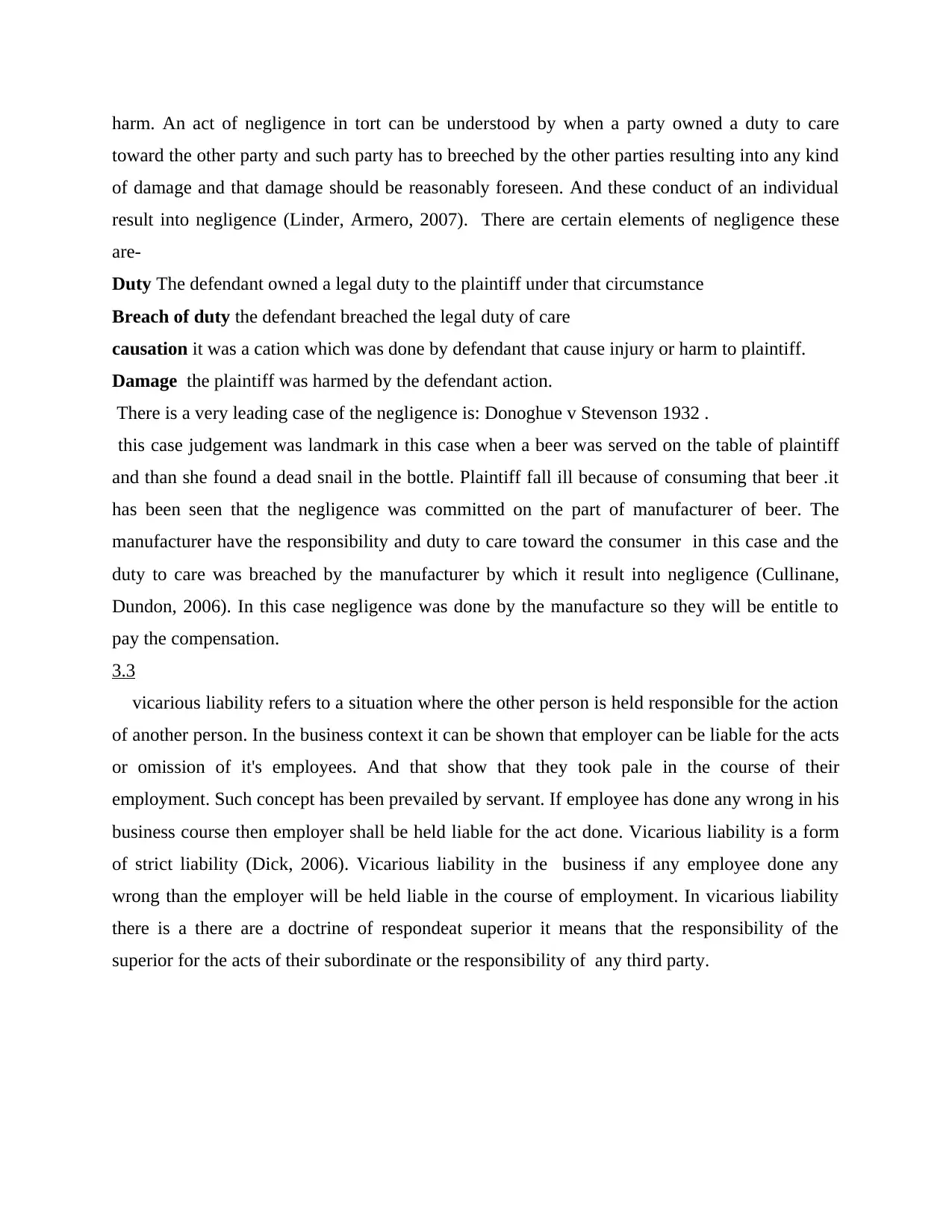
harm. An act of negligence in tort can be understood by when a party owned a duty to care
toward the other party and such party has to breeched by the other parties resulting into any kind
of damage and that damage should be reasonably foreseen. And these conduct of an individual
result into negligence (Linder, Armero, 2007). There are certain elements of negligence these
are-
Duty The defendant owned a legal duty to the plaintiff under that circumstance
Breach of duty the defendant breached the legal duty of care
causation it was a cation which was done by defendant that cause injury or harm to plaintiff.
Damage the plaintiff was harmed by the defendant action.
There is a very leading case of the negligence is: Donoghue v Stevenson 1932 .
this case judgement was landmark in this case when a beer was served on the table of plaintiff
and than she found a dead snail in the bottle. Plaintiff fall ill because of consuming that beer .it
has been seen that the negligence was committed on the part of manufacturer of beer. The
manufacturer have the responsibility and duty to care toward the consumer in this case and the
duty to care was breached by the manufacturer by which it result into negligence (Cullinane,
Dundon, 2006). In this case negligence was done by the manufacture so they will be entitle to
pay the compensation.
3.3
vicarious liability refers to a situation where the other person is held responsible for the action
of another person. In the business context it can be shown that employer can be liable for the acts
or omission of it's employees. And that show that they took pale in the course of their
employment. Such concept has been prevailed by servant. If employee has done any wrong in his
business course then employer shall be held liable for the act done. Vicarious liability is a form
of strict liability (Dick, 2006). Vicarious liability in the business if any employee done any
wrong than the employer will be held liable in the course of employment. In vicarious liability
there is a there are a doctrine of respondeat superior it means that the responsibility of the
superior for the acts of their subordinate or the responsibility of any third party.
toward the other party and such party has to breeched by the other parties resulting into any kind
of damage and that damage should be reasonably foreseen. And these conduct of an individual
result into negligence (Linder, Armero, 2007). There are certain elements of negligence these
are-
Duty The defendant owned a legal duty to the plaintiff under that circumstance
Breach of duty the defendant breached the legal duty of care
causation it was a cation which was done by defendant that cause injury or harm to plaintiff.
Damage the plaintiff was harmed by the defendant action.
There is a very leading case of the negligence is: Donoghue v Stevenson 1932 .
this case judgement was landmark in this case when a beer was served on the table of plaintiff
and than she found a dead snail in the bottle. Plaintiff fall ill because of consuming that beer .it
has been seen that the negligence was committed on the part of manufacturer of beer. The
manufacturer have the responsibility and duty to care toward the consumer in this case and the
duty to care was breached by the manufacturer by which it result into negligence (Cullinane,
Dundon, 2006). In this case negligence was done by the manufacture so they will be entitle to
pay the compensation.
3.3
vicarious liability refers to a situation where the other person is held responsible for the action
of another person. In the business context it can be shown that employer can be liable for the acts
or omission of it's employees. And that show that they took pale in the course of their
employment. Such concept has been prevailed by servant. If employee has done any wrong in his
business course then employer shall be held liable for the act done. Vicarious liability is a form
of strict liability (Dick, 2006). Vicarious liability in the business if any employee done any
wrong than the employer will be held liable in the course of employment. In vicarious liability
there is a there are a doctrine of respondeat superior it means that the responsibility of the
superior for the acts of their subordinate or the responsibility of any third party.
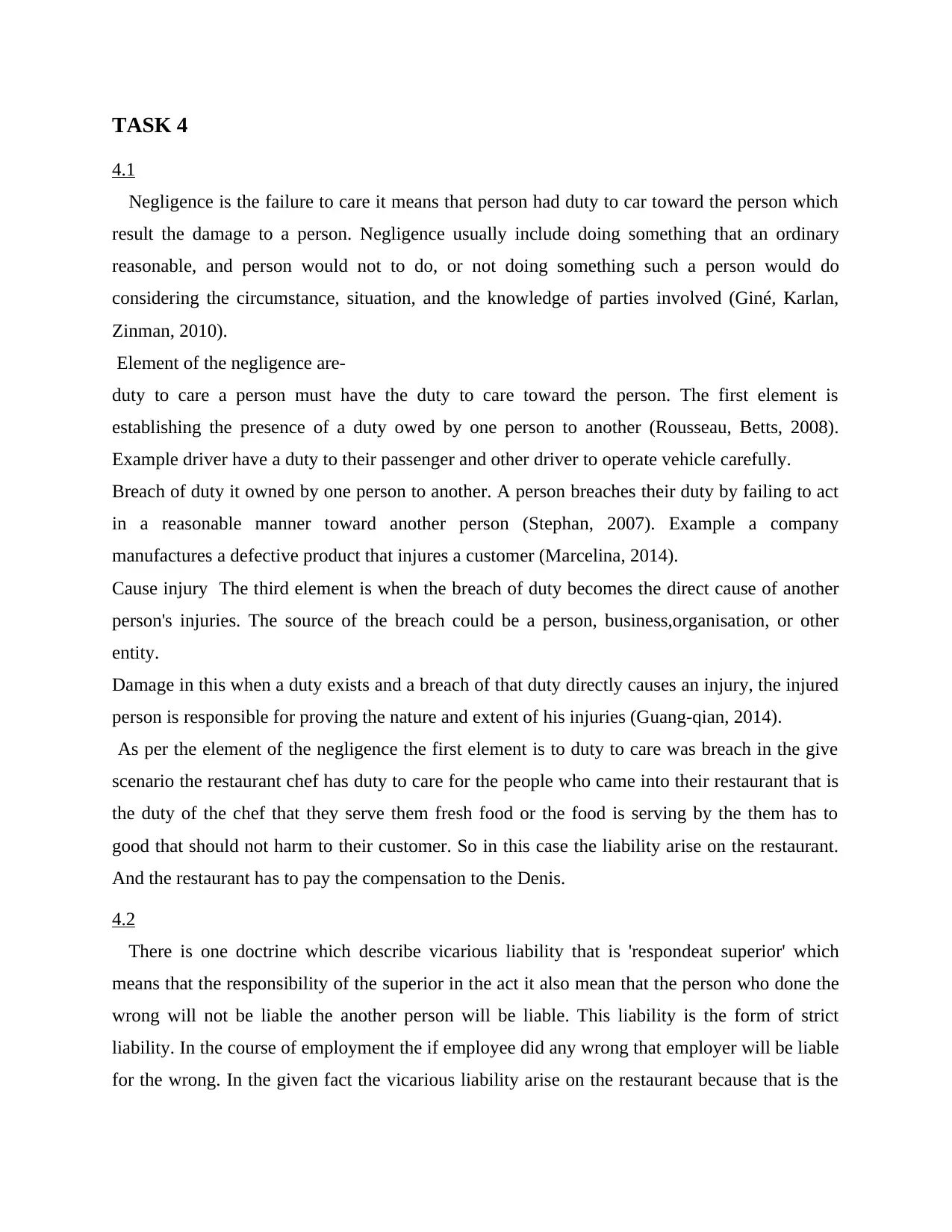
TASK 4
4.1
Negligence is the failure to care it means that person had duty to car toward the person which
result the damage to a person. Negligence usually include doing something that an ordinary
reasonable, and person would not to do, or not doing something such a person would do
considering the circumstance, situation, and the knowledge of parties involved (Giné, Karlan,
Zinman, 2010).
Element of the negligence are-
duty to care a person must have the duty to care toward the person. The first element is
establishing the presence of a duty owed by one person to another (Rousseau, Betts, 2008).
Example driver have a duty to their passenger and other driver to operate vehicle carefully.
Breach of duty it owned by one person to another. A person breaches their duty by failing to act
in a reasonable manner toward another person (Stephan, 2007). Example a company
manufactures a defective product that injures a customer (Marcelina, 2014).
Cause injury The third element is when the breach of duty becomes the direct cause of another
person's injuries. The source of the breach could be a person, business,organisation, or other
entity.
Damage in this when a duty exists and a breach of that duty directly causes an injury, the injured
person is responsible for proving the nature and extent of his injuries (Guang-qian, 2014).
As per the element of the negligence the first element is to duty to care was breach in the give
scenario the restaurant chef has duty to care for the people who came into their restaurant that is
the duty of the chef that they serve them fresh food or the food is serving by the them has to
good that should not harm to their customer. So in this case the liability arise on the restaurant.
And the restaurant has to pay the compensation to the Denis.
4.2
There is one doctrine which describe vicarious liability that is 'respondeat superior' which
means that the responsibility of the superior in the act it also mean that the person who done the
wrong will not be liable the another person will be liable. This liability is the form of strict
liability. In the course of employment the if employee did any wrong that employer will be liable
for the wrong. In the given fact the vicarious liability arise on the restaurant because that is the
4.1
Negligence is the failure to care it means that person had duty to car toward the person which
result the damage to a person. Negligence usually include doing something that an ordinary
reasonable, and person would not to do, or not doing something such a person would do
considering the circumstance, situation, and the knowledge of parties involved (Giné, Karlan,
Zinman, 2010).
Element of the negligence are-
duty to care a person must have the duty to care toward the person. The first element is
establishing the presence of a duty owed by one person to another (Rousseau, Betts, 2008).
Example driver have a duty to their passenger and other driver to operate vehicle carefully.
Breach of duty it owned by one person to another. A person breaches their duty by failing to act
in a reasonable manner toward another person (Stephan, 2007). Example a company
manufactures a defective product that injures a customer (Marcelina, 2014).
Cause injury The third element is when the breach of duty becomes the direct cause of another
person's injuries. The source of the breach could be a person, business,organisation, or other
entity.
Damage in this when a duty exists and a breach of that duty directly causes an injury, the injured
person is responsible for proving the nature and extent of his injuries (Guang-qian, 2014).
As per the element of the negligence the first element is to duty to care was breach in the give
scenario the restaurant chef has duty to care for the people who came into their restaurant that is
the duty of the chef that they serve them fresh food or the food is serving by the them has to
good that should not harm to their customer. So in this case the liability arise on the restaurant.
And the restaurant has to pay the compensation to the Denis.
4.2
There is one doctrine which describe vicarious liability that is 'respondeat superior' which
means that the responsibility of the superior in the act it also mean that the person who done the
wrong will not be liable the another person will be liable. This liability is the form of strict
liability. In the course of employment the if employee did any wrong that employer will be liable
for the wrong. In the given fact the vicarious liability arise on the restaurant because that is the
⊘ This is a preview!⊘
Do you want full access?
Subscribe today to unlock all pages.

Trusted by 1+ million students worldwide
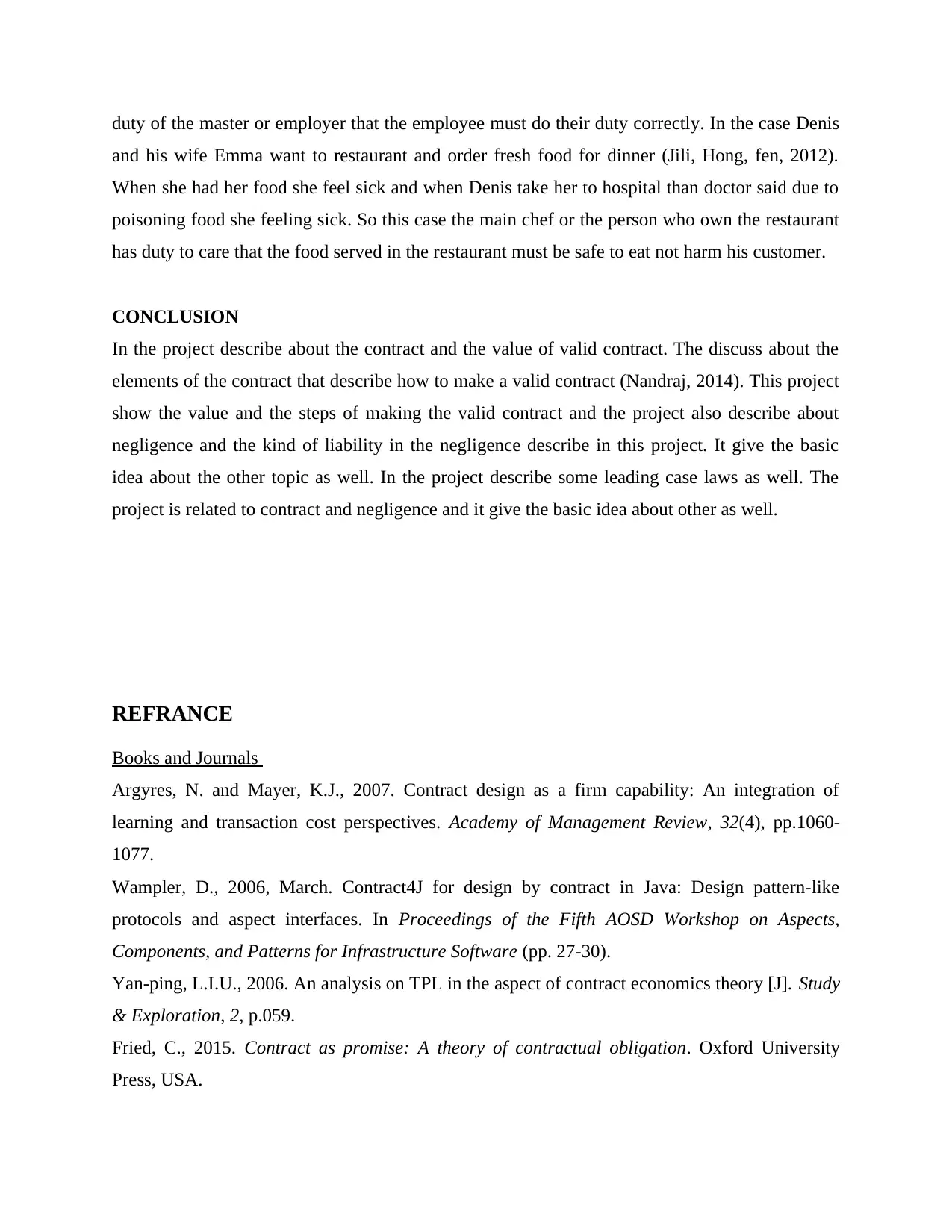
duty of the master or employer that the employee must do their duty correctly. In the case Denis
and his wife Emma want to restaurant and order fresh food for dinner (Jili, Hong, fen, 2012).
When she had her food she feel sick and when Denis take her to hospital than doctor said due to
poisoning food she feeling sick. So this case the main chef or the person who own the restaurant
has duty to care that the food served in the restaurant must be safe to eat not harm his customer.
CONCLUSION
In the project describe about the contract and the value of valid contract. The discuss about the
elements of the contract that describe how to make a valid contract (Nandraj, 2014). This project
show the value and the steps of making the valid contract and the project also describe about
negligence and the kind of liability in the negligence describe in this project. It give the basic
idea about the other topic as well. In the project describe some leading case laws as well. The
project is related to contract and negligence and it give the basic idea about other as well.
REFRANCE
Books and Journals
Argyres, N. and Mayer, K.J., 2007. Contract design as a firm capability: An integration of
learning and transaction cost perspectives. Academy of Management Review, 32(4), pp.1060-
1077.
Wampler, D., 2006, March. Contract4J for design by contract in Java: Design pattern-like
protocols and aspect interfaces. In Proceedings of the Fifth AOSD Workshop on Aspects,
Components, and Patterns for Infrastructure Software (pp. 27-30).
Yan-ping, L.I.U., 2006. An analysis on TPL in the aspect of contract economics theory [J]. Study
& Exploration, 2, p.059.
Fried, C., 2015. Contract as promise: A theory of contractual obligation. Oxford University
Press, USA.
and his wife Emma want to restaurant and order fresh food for dinner (Jili, Hong, fen, 2012).
When she had her food she feel sick and when Denis take her to hospital than doctor said due to
poisoning food she feeling sick. So this case the main chef or the person who own the restaurant
has duty to care that the food served in the restaurant must be safe to eat not harm his customer.
CONCLUSION
In the project describe about the contract and the value of valid contract. The discuss about the
elements of the contract that describe how to make a valid contract (Nandraj, 2014). This project
show the value and the steps of making the valid contract and the project also describe about
negligence and the kind of liability in the negligence describe in this project. It give the basic
idea about the other topic as well. In the project describe some leading case laws as well. The
project is related to contract and negligence and it give the basic idea about other as well.
REFRANCE
Books and Journals
Argyres, N. and Mayer, K.J., 2007. Contract design as a firm capability: An integration of
learning and transaction cost perspectives. Academy of Management Review, 32(4), pp.1060-
1077.
Wampler, D., 2006, March. Contract4J for design by contract in Java: Design pattern-like
protocols and aspect interfaces. In Proceedings of the Fifth AOSD Workshop on Aspects,
Components, and Patterns for Infrastructure Software (pp. 27-30).
Yan-ping, L.I.U., 2006. An analysis on TPL in the aspect of contract economics theory [J]. Study
& Exploration, 2, p.059.
Fried, C., 2015. Contract as promise: A theory of contractual obligation. Oxford University
Press, USA.
Paraphrase This Document
Need a fresh take? Get an instant paraphrase of this document with our AI Paraphraser
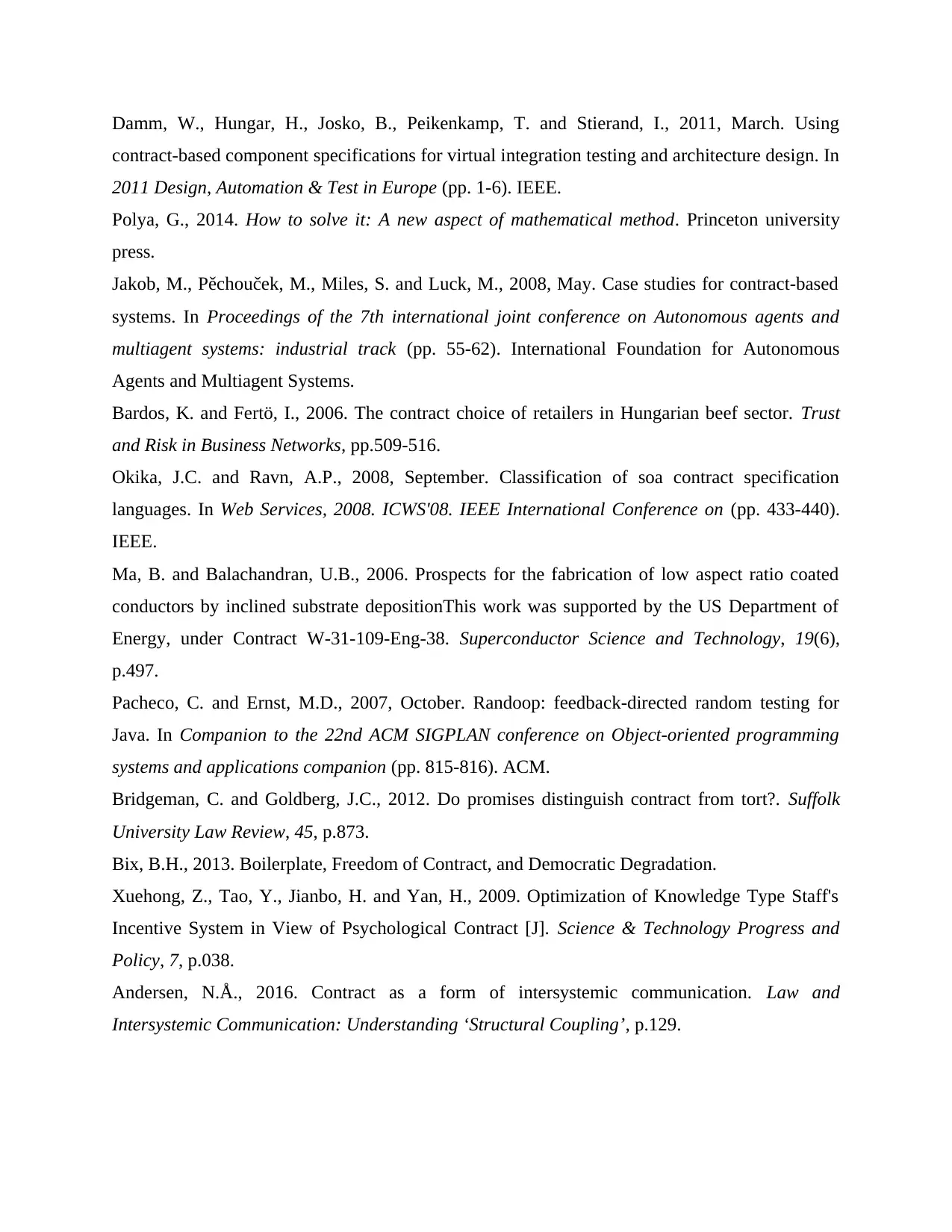
Damm, W., Hungar, H., Josko, B., Peikenkamp, T. and Stierand, I., 2011, March. Using
contract-based component specifications for virtual integration testing and architecture design. In
2011 Design, Automation & Test in Europe (pp. 1-6). IEEE.
Polya, G., 2014. How to solve it: A new aspect of mathematical method. Princeton university
press.
Jakob, M., Pěchouček, M., Miles, S. and Luck, M., 2008, May. Case studies for contract-based
systems. In Proceedings of the 7th international joint conference on Autonomous agents and
multiagent systems: industrial track (pp. 55-62). International Foundation for Autonomous
Agents and Multiagent Systems.
Bardos, K. and Fertö, I., 2006. The contract choice of retailers in Hungarian beef sector. Trust
and Risk in Business Networks, pp.509-516.
Okika, J.C. and Ravn, A.P., 2008, September. Classification of soa contract specification
languages. In Web Services, 2008. ICWS'08. IEEE International Conference on (pp. 433-440).
IEEE.
Ma, B. and Balachandran, U.B., 2006. Prospects for the fabrication of low aspect ratio coated
conductors by inclined substrate depositionThis work was supported by the US Department of
Energy, under Contract W-31-109-Eng-38. Superconductor Science and Technology, 19(6),
p.497.
Pacheco, C. and Ernst, M.D., 2007, October. Randoop: feedback-directed random testing for
Java. In Companion to the 22nd ACM SIGPLAN conference on Object-oriented programming
systems and applications companion (pp. 815-816). ACM.
Bridgeman, C. and Goldberg, J.C., 2012. Do promises distinguish contract from tort?. Suffolk
University Law Review, 45, p.873.
Bix, B.H., 2013. Boilerplate, Freedom of Contract, and Democratic Degradation.
Xuehong, Z., Tao, Y., Jianbo, H. and Yan, H., 2009. Optimization of Knowledge Type Staff's
Incentive System in View of Psychological Contract [J]. Science & Technology Progress and
Policy, 7, p.038.
Andersen, N.Å., 2016. Contract as a form of intersystemic communication. Law and
Intersystemic Communication: Understanding ‘Structural Coupling’, p.129.
contract-based component specifications for virtual integration testing and architecture design. In
2011 Design, Automation & Test in Europe (pp. 1-6). IEEE.
Polya, G., 2014. How to solve it: A new aspect of mathematical method. Princeton university
press.
Jakob, M., Pěchouček, M., Miles, S. and Luck, M., 2008, May. Case studies for contract-based
systems. In Proceedings of the 7th international joint conference on Autonomous agents and
multiagent systems: industrial track (pp. 55-62). International Foundation for Autonomous
Agents and Multiagent Systems.
Bardos, K. and Fertö, I., 2006. The contract choice of retailers in Hungarian beef sector. Trust
and Risk in Business Networks, pp.509-516.
Okika, J.C. and Ravn, A.P., 2008, September. Classification of soa contract specification
languages. In Web Services, 2008. ICWS'08. IEEE International Conference on (pp. 433-440).
IEEE.
Ma, B. and Balachandran, U.B., 2006. Prospects for the fabrication of low aspect ratio coated
conductors by inclined substrate depositionThis work was supported by the US Department of
Energy, under Contract W-31-109-Eng-38. Superconductor Science and Technology, 19(6),
p.497.
Pacheco, C. and Ernst, M.D., 2007, October. Randoop: feedback-directed random testing for
Java. In Companion to the 22nd ACM SIGPLAN conference on Object-oriented programming
systems and applications companion (pp. 815-816). ACM.
Bridgeman, C. and Goldberg, J.C., 2012. Do promises distinguish contract from tort?. Suffolk
University Law Review, 45, p.873.
Bix, B.H., 2013. Boilerplate, Freedom of Contract, and Democratic Degradation.
Xuehong, Z., Tao, Y., Jianbo, H. and Yan, H., 2009. Optimization of Knowledge Type Staff's
Incentive System in View of Psychological Contract [J]. Science & Technology Progress and
Policy, 7, p.038.
Andersen, N.Å., 2016. Contract as a form of intersystemic communication. Law and
Intersystemic Communication: Understanding ‘Structural Coupling’, p.129.
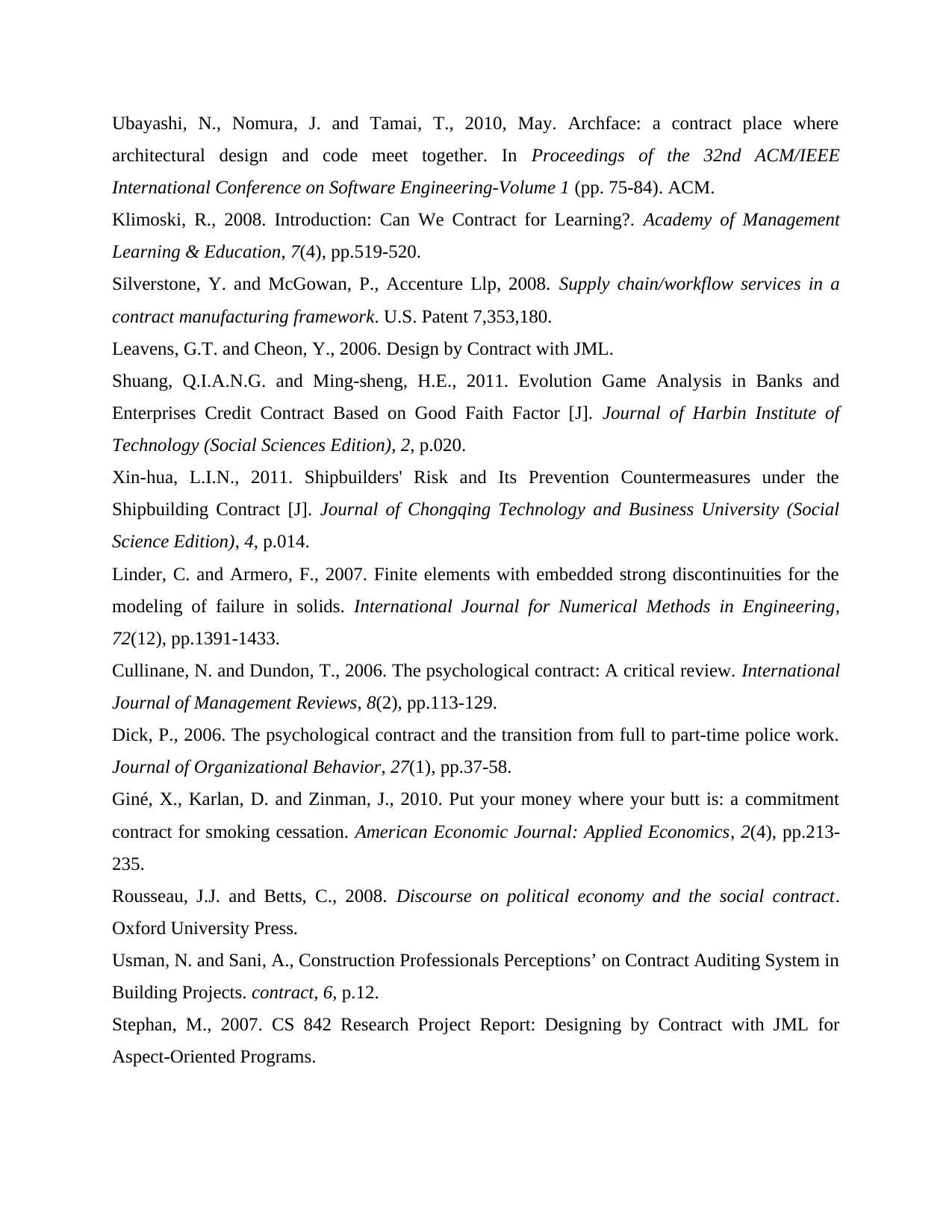
Ubayashi, N., Nomura, J. and Tamai, T., 2010, May. Archface: a contract place where
architectural design and code meet together. In Proceedings of the 32nd ACM/IEEE
International Conference on Software Engineering-Volume 1 (pp. 75-84). ACM.
Klimoski, R., 2008. Introduction: Can We Contract for Learning?. Academy of Management
Learning & Education, 7(4), pp.519-520.
Silverstone, Y. and McGowan, P., Accenture Llp, 2008. Supply chain/workflow services in a
contract manufacturing framework. U.S. Patent 7,353,180.
Leavens, G.T. and Cheon, Y., 2006. Design by Contract with JML.
Shuang, Q.I.A.N.G. and Ming-sheng, H.E., 2011. Evolution Game Analysis in Banks and
Enterprises Credit Contract Based on Good Faith Factor [J]. Journal of Harbin Institute of
Technology (Social Sciences Edition), 2, p.020.
Xin-hua, L.I.N., 2011. Shipbuilders' Risk and Its Prevention Countermeasures under the
Shipbuilding Contract [J]. Journal of Chongqing Technology and Business University (Social
Science Edition), 4, p.014.
Linder, C. and Armero, F., 2007. Finite elements with embedded strong discontinuities for the
modeling of failure in solids. International Journal for Numerical Methods in Engineering,
72(12), pp.1391-1433.
Cullinane, N. and Dundon, T., 2006. The psychological contract: A critical review. International
Journal of Management Reviews, 8(2), pp.113-129.
Dick, P., 2006. The psychological contract and the transition from full to part‐time police work.
Journal of Organizational Behavior, 27(1), pp.37-58.
Giné, X., Karlan, D. and Zinman, J., 2010. Put your money where your butt is: a commitment
contract for smoking cessation. American Economic Journal: Applied Economics, 2(4), pp.213-
235.
Rousseau, J.J. and Betts, C., 2008. Discourse on political economy and the social contract.
Oxford University Press.
Usman, N. and Sani, A., Construction Professionals Perceptions’ on Contract Auditing System in
Building Projects. contract, 6, p.12.
Stephan, M., 2007. CS 842 Research Project Report: Designing by Contract with JML for
Aspect-Oriented Programs.
architectural design and code meet together. In Proceedings of the 32nd ACM/IEEE
International Conference on Software Engineering-Volume 1 (pp. 75-84). ACM.
Klimoski, R., 2008. Introduction: Can We Contract for Learning?. Academy of Management
Learning & Education, 7(4), pp.519-520.
Silverstone, Y. and McGowan, P., Accenture Llp, 2008. Supply chain/workflow services in a
contract manufacturing framework. U.S. Patent 7,353,180.
Leavens, G.T. and Cheon, Y., 2006. Design by Contract with JML.
Shuang, Q.I.A.N.G. and Ming-sheng, H.E., 2011. Evolution Game Analysis in Banks and
Enterprises Credit Contract Based on Good Faith Factor [J]. Journal of Harbin Institute of
Technology (Social Sciences Edition), 2, p.020.
Xin-hua, L.I.N., 2011. Shipbuilders' Risk and Its Prevention Countermeasures under the
Shipbuilding Contract [J]. Journal of Chongqing Technology and Business University (Social
Science Edition), 4, p.014.
Linder, C. and Armero, F., 2007. Finite elements with embedded strong discontinuities for the
modeling of failure in solids. International Journal for Numerical Methods in Engineering,
72(12), pp.1391-1433.
Cullinane, N. and Dundon, T., 2006. The psychological contract: A critical review. International
Journal of Management Reviews, 8(2), pp.113-129.
Dick, P., 2006. The psychological contract and the transition from full to part‐time police work.
Journal of Organizational Behavior, 27(1), pp.37-58.
Giné, X., Karlan, D. and Zinman, J., 2010. Put your money where your butt is: a commitment
contract for smoking cessation. American Economic Journal: Applied Economics, 2(4), pp.213-
235.
Rousseau, J.J. and Betts, C., 2008. Discourse on political economy and the social contract.
Oxford University Press.
Usman, N. and Sani, A., Construction Professionals Perceptions’ on Contract Auditing System in
Building Projects. contract, 6, p.12.
Stephan, M., 2007. CS 842 Research Project Report: Designing by Contract with JML for
Aspect-Oriented Programs.
⊘ This is a preview!⊘
Do you want full access?
Subscribe today to unlock all pages.

Trusted by 1+ million students worldwide
1 out of 14
Related Documents
Your All-in-One AI-Powered Toolkit for Academic Success.
+13062052269
info@desklib.com
Available 24*7 on WhatsApp / Email
![[object Object]](/_next/static/media/star-bottom.7253800d.svg)
Unlock your academic potential
Copyright © 2020–2025 A2Z Services. All Rights Reserved. Developed and managed by ZUCOL.





